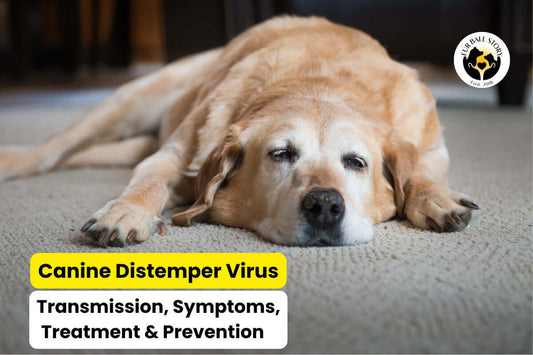"Pawsome Trends: Top Picks in Dog Blogs"

Canine Distemper Virus: Transmission, Symptoms,...
Canine distemper is a serious and contagious disease that affects dogs of all ages. It is one of the most common viral diseases in dogs. It is highly contagious and...
Canine Distemper Virus: Transmission, Symptoms,...
Canine distemper is one of the most common viral diseases in dogs. It is highly contagious and affects dogs worldwide. Through our blog on Canine Distemper Virus: Transmission, Symptoms, Treatment & Prevention, learn essential facts every pet parent must know. What is Canine Distemper? Also known as Hard Pad Disease, it is caused by the Canine Distemper Virus (CDV). It attacks multiple systems in the body, including the respiratory tract, gastrointestinal system, and nervous system and leads to long-term complications for infected dogs. How is Canine Distemper Transmitted? The Canine Distemper Virus spreads through bodily fluids such as saliva, urine or droplets from coughing or sneezing. It initially occurs in the lymphatic tissue of the respiratory tract and is followed by infection of the brain, respiratory, gastrointestinal, and urogenital systems. The virus keeps replicating in these tissues. The immunity of the affected animal plays a major role in the degree of transmission. Hot spots of the disease include dog parks, kennels, and veterinary clinics. Canine Distemper Symptoms The symptoms of canine distemper can vary depending on the stage of infection and which systems of the body are affected. In the early stages, the dog might show general signs of illness, such as fever, loss of appetite, lethargy or discharge from eyes & nose. As the disease progresses, Canine Distemper Signs can include: Respiratory symptoms: Coughing, difficulty breathing, discharge from the eyes and nose Gastrointestinal symptoms: Vomiting, diarrhea, reduced appetite Neurological signs: Ataxia (stumbling), head tilt, paralysis, temporal twitching observed on the head Pyrexia: Constant high fever Other signs: Fever, lethargy, shaking, tremors After effects of this disease can include long-term neurological effects, such as tremors, seizures, and behavioral changes. Canine Distemper Treatment Unfortunately, there is no cure for canine distemper once a dog is infected. Distemper can become serious quickly, leading to a high mortality rate, especially in puppies. Moreover, its treatment is only symptomatic and there are very less chances of survival. The earlier treatment starts, the better the chance of recovery. Treatment includes supportive care with the following options for recovery: I/V fluid therapy to prevent dehydration Antibiotics to manage secondary bacterial infections Antiemetics to relieve nausea Antacids to neutralize stomach acid Nerve tonics to support the nervous system Dogs with severe symptoms, especially neurological ones, may require long-term care and management. The outcome depends on how early the disease is detected, how severe the symptoms are, and how well the dog responds to treatment. How Can You Prevent Canine Distemper? Canine distemper can be prevented through vaccination. The core vaccine that protects against distemper is the DHPP vaccine, which also covers parvovirus, hepatitis, and parainfluenza. The first shot is given at the age of 45 days while two more shots are given at the gap of 21 days. Additionally, you can keep your dog safe with: Regular vaccination & vet checkups Limiting your pet’s contact with outside dogs Keeping unvaccinated puppies at home We've Got You Covered! Supertonic Syrup is a daily dose of nutrition that boosts your pet's immunity and improve their quality of life. It is a natural pet wellness syrup to ensure head-to-tail wellness of pets. It addresses multiple aspects of your dog's health like kidneys, liver, gut, digestion, skin, brain and others. Conclusion Canine distemper is a serious and contagious disease that affects dogs of all ages. However, with proper vaccination, pet owners can proactively prevent this disease. If your dog has been exposed to distemper or is showing symptoms, immediately contact your veterinarian. Early diagnosis means better chances of providing effective care and treatment. Ensure a healthy life for your pet, Stay Tuned!

Best Herbs for Dogs and Their Health Benefits
Herbs are an excellent addition to your dog's everyday diet and wellness routines. Packed with vitamins, antioxidants, and anti-inflammatory properties, these natural remedies support digestion, boost immunity, reduce stress, and...
Best Herbs for Dogs and Their Health Benefits
Herbs are an excellent addition to your dog's everyday diet and wellness routines. Packed with vitamins, antioxidants, and anti-inflammatory properties, these natural remedies support digestion, boost immunity, reduce stress, and promote overall wellness. So boost your dog’s health with the power of nature. However, consulting your vet before adding any new herb to your dog's diet is crucial. Turmeric [Haldi] Cumin seeds [Jeera] Carom seeds [Ajwain] Asafoetida [Heeing] Coriander [Dhaniya] Mint [Pudina] 1. Turmeric [Haldi] Add a small amount of turmeric powder directly to your dog’s food. Start with a smaller dose and gradually increase it over time. For better absorption, mix turmeric with coconut oil. For additional benefits, add a pinch of black pepper. Start Gradually Always introduce turmeric slowly to monitor your dog's reaction and avoid potential digestive problems. Mix Directly with Food Sprinkle turmeric powder directly onto your dog's regular food for easy administration. Consider a Golden PasteYou can also prepare a turmeric paste by mixing turmeric powder with water and coconut oil. Now top up their food with this paste. Black Pepper BoostAdding a small amount of black pepper can significantly increase turmeric's absorption in your dog's body. Consult Your VetSome dogs may experience gastric upset or an allergic reaction to turmeric. So before introducing turmeric to your dog, always consult your veterinarian to ensure it is suitable for them and discuss the correct dosage. 2. Cumin Seeds [Jeera] Dogs can eat cumin seeds in small amounts as a flavoured supplement to their food or homemade treats. Cumin offers several health benefits like boosting digestion, aiding in weight management due to its metabolic boost, and providing necessary antioxidants. Other potential benefits also include immune system support and improved digestion due to its digestive enzymes. However, it is important to note that dogs can only tolerate small quantities of cumin and too much cumin can cause stomach upset and digestive issues in dogs. 3. Carom Seeds [Ajwain] Carom seeds, also known as ajwain seeds, are beneficial for dogs in several ways, including: Digestive HealthAjwain seeds can help to ease indigestion, bloating, and gas. They can also treat peptic ulcers and sores in the stomach, oesophagus, and intestines. Non-toxicAjwain seeds are generally non-toxic to dogs and are safe for pet-friendly homes. Muscle HealthCarom seeds are considered a warming herb that can benefit a dog's muscle health. AntioxidantsCarom seeds are rich in antioxidants that can help fight cancer. 4. Asafoetida [Heeing] Adding a small amount of asafoetida to a dog's diet may potentially help with digestion by acting as a carminative, reducing bloating and gas, thanks to its ability to stimulate digestive enzymes and bile flow, making it beneficial for dogs experiencing occasional digestive upset or flatulence. Key potential benefits of asafoetida for dogs: Aids digestion:Asafoetida is known for its digestive-stimulating properties, which can help with gas, bloating, and discomfort in the stomach. Reduces appetite loss:By improving digestion, it may help dogs with a decreased appetite eat more readily. Anti-spasmodic effect:May help alleviate stomach cramps or spasms due to its antispasmodic properties. Potential anti-inflammatory effects:Some studies suggest asafoetida may have anti-inflammatory properties which could be beneficial for dogs with certain digestive issues. However, it's important to use it in very small quantities due to its strong odor and potential for irritation, and always consult your veterinarian before adding any new supplement to your dog's diet. 5. Coriander Leaves [Dhaniya] Coriander, also known as cilantro, can have several health benefits for dogs, including: Digestion: Coriander can ease nausea, flatulence, and diarrhea. It can also soothe stomach upset and digestive issues. Parasites: Coriander has antiparasitic effects that can help control worms and parasites. Blood clotting: It is rich in vitamin K, which is important for blood clotting. Cell growth: Coriander leaves are also rich in folate, which supports cell growth. Immune system: Coriander is high in antioxidants, vitamin A, and vitamin C, which support a healthy immune system. Skin: Coriander is high in vitamin K, which also promotes healthy skin. Bones: Coriander is a good source of magnesium, calcium, manganese, and potassium, which strengthen the bones. Breath: Coriander freshens up your dog's breath. You can add coriander to your dog's diet by sprinkling ground coriander over their meal, making homemade treats, or using cilantro pops. However, you should never give coriander to pregnant or lactating dogs, as it may cause uterine spasms or stimulate milk production. 6. Mint [Pudina] Mint can be added to your dog's diet by sprinkling a little fresh or dried mint over their food o making homemade biscuits with mint. It has several health benefits for dogs, including: Freshens breath: Mint's cooling effect on the tongue eliminates bad breath Aids digestion: It regulates digestion, similar to how mint tea is used by humans Anti-inflammatory: Mint has anti-inflammatory properties Antioxidants: Mint is a rich source of antioxidants that protect against cell oxidation and free radical damage Nutrients: Mint is enriched with vitamins A and C, as well as calcium, magnesium, iron, copper, and zinc Seasonal allergies: The rosmarinic acid in mint relieves seasonal allergies Nasal decongestant: The natural menthol in mint acts as a nasal decongestant However, not all mint varieties are safe for dogs. Pennyroyal mint is toxic to dogs and should be avoided completely. Feeding too much mint can also cause gastrointestinal distress. If your dog eats mint and experiences vomiting, diarrhea, or weakness, you should call your vet immediately. Remember: Before introducing any of these spices to your pet, always consult your veterinarian. Your dog can be allergic to any of these ingredients. Thus, seek veterinary advice on the right quantity based on their age, breed and body weight. All these spices are healthy for your dog’s health but you should always feed them in moderation.

Potty Training Dogs: Easy Tips to Make your Pet...
Bringing a new pet home? Training them on when and where to poop is essential to keep your home tidy and mess-free. This basic life skill must be consistently taught...
Potty Training Dogs: Easy Tips to Make your Pet...
Bringing a new pet home? Training them on when and where to poop is essential to keep your home tidy and mess-free. This basic life skill must be consistently taught to your pet from a young age. We understand that training becomes easier once you know the basic dos and don'ts. Check out the blog ‘Potty Training Your Dog: A Step-by-Step Guide’ to make your pet parenting journey smoother. 1. Prepare a Timetable Puppies have a higher rate of metabolism due to which they relieve themselves more frequently. So it is necessary to set a regular feeding schedule, to help regulate their bathroom habits. Take them out for walks in the morning, after waking up, and before going to bed. Once you have the schedule ready, fix a potty spot for them. 2. Fix a Potty Spot Taking your pet outside might not always be possible, so fix an indoor spot to poop. For this, you can fix pee pads in the designated area. Each time, take them to the same spot to help them know where to defecate. Do not keep changing the designated spot as it might lead to confusion. Puppies remember the smell of urine and start to recognise the area as their toilet area. Until your puppy receives their third set of vaccines, avoid areas where other dogs also pee/poop, to avoid infections. 3. Observe your Pooch You need to be more vigilant, especially during the initial stages of potty training. Watch for signs such as circling or squatting. When you see these signs, quickly take them to their potty spot as they might be signaling to freshen up. Just like chihuahuas have small bladders and pee more frequently, similarly, research your dog’s breed traits to know them better. 4. Rewards and Remarks When your puppy goes to potty in the designated area, praise them with comments like ‘good boy/girl’ and their favourite treats. Positive remarks also help to bring out the desired behaviour and encourage sticking to the right spot. Use a cheerful, happy remark to motivate your pup. Being consistent will give them an emotional incentive to do their business in the correct place. 5. Be Patient and Consistent Potty training requires your time and patience. It can take around 4-12 months to fully train your pooch. Stay consistent with your efforts, routine and training methods. You might often face setbacks and accidents. However, don't get discouraged by them and continue rewarding good behaviour. Potty training takes time and patience. It's essential to remain consistent with your routine and training methods. If your puppy faces an accident, don't get discouraged. Stay positive and continue promoting good behaviour. Conclusion Potty training your puppy requires patience, consistency, and positive reinforcement. Getting the first few exposures right can make the rest of your training a breeze! By following these steps and staying consistent to the process, you can successfully teach your puppy where and when to poop. Remember to be patient and enjoy the journey of pet parenting with your furry friend. Wondering how to provide your puppy the best care? Puppy Starter Combo Pack is for you! It consists of CanniVin Puppy Supplement and Puppy Care Shampoo which ensure external as well as internal nourishment of your pup. FAQs: How to Potty Train Dogs? Why do we take our dogs for walks but not cats? Dogs poop outside during walks white cats have a litter space at home Cats feel safe in their own space, while dogs need more socialization Dogs need more physical exposure while cats do it on their own Risk of attack by other animals is higher in cats, making them vulnerable Cats pose a high risk of running away if the leash is left by mistake What is the right potty training schedule for dogs? Take your puppy outside every two hours and right after they wake up. Also, take them out after eating and playing. Taking them to the same spot each time will help with training. What is the time required to potty train puppies? Generally, it takes 4-6 months for a puppy to be fully potty trained. However, some puppies may take around a year depending on their individual needs. What can be problems faced by new parents? New puppies can face indigestion issues due to stress. To provide them relief, Pacho Pet is a natural medicine that soothes the digestive tract and improves digestion.
